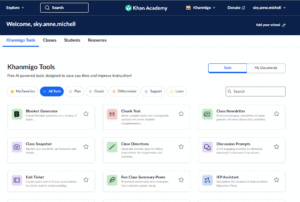I’ll be honest – when I first heard about AI tools being used in education, I was a little skeptical. Like many people, I had this image of robots taking over classrooms or students relying on machines to do all the thinking. But the more I’ve learned about it, the more I’ve come to see the incredible (albeit somewhat creepy-realistic) potential AI has – not to replace teachers, but to support them.
As someone working in schools while preparing to enter the teaching profession, I can see how complex the role of a teacher has become. Having a tool like AI in the classroom can really help with meeting the individual needs of every student. It has the power to make learning more responsive, inclusive, and engaging when used with intention. For example, AI can analyze student progress and suggest resources, activities, or even adjust pacing based on what each learner needs.
But here’s the thing: at the end of the day, the heart of teaching is still relationships. No technology can replace the human connection that happens when a teacher sees a student light up with understanding or takes time to check in on how they’re doing.
A Helpful Tool
Khanmigo is an AI-powered tutor built by Khan Academy, and I was genuinely impressed by how well it can support learners of all kinds. What I loved most is that students can ask follow-up questions and get things explained in different ways, without any fear of judgement. That’s huge for kids who might be too shy to speak up in class. Khanmigo also offers great tools for teachers, including step-by=step guides for getting started with AI in the classroom, ideas for using it responsibly, and reminders to keep human connection at the center of learning. As a future teacher still figuring out how to meaningfully bring tech into my practice, I found that incredibly reassuring.


As a parent, I also saw the value immediately. I could relate to those chaotic homework nights where your child is frustrated, and you’re googling how to divide fractions because now there’s “new math”. Khamingo can help take some of that stress away by walking students (and parents) through problems clearly and calmly, helping everyone get through it a little easier.
What really sold me though, was the reassurance that it doesn’t just hand over the answers. It nudges kids in the right direction with hints and guiding questions, encouraging them to think through problems and not give up when it gets tough. That’s the kind of learning that sticks = the kind that builds confidence, independence, and problem-solving skills. And that is exactly the kind of mindset I want to encourage and nurture in my future classroom.
Final Thoughts
So, am I still a little cautious about AI in education? Yeah, for sure. But I’m also really excited about what it can do. When it’s used with care and purpose, AI doesn’t take away the magic of teaching – it actually adds to it. That said, it’s more important than ever to teach students about digital literacy. With AI becoming more and more realistic, kids need to learn how to think critically about what they’re seeing, question what is real, and use these tools responsibly.

One Comment
Kallie Lumbard
I really enjoyed diving into your perspective on AI in education. Its extremely true that AI cannot replace the human connection we build while teaching. However, it can be a very powerful tool when used carefully. A part that stood out to me is when you highlighted Khanmingo ability to still support students and teachers without doing all the thinking for them. The most important point as you said is teaching kids how to safely and critically use AI, which I 100% agree with.